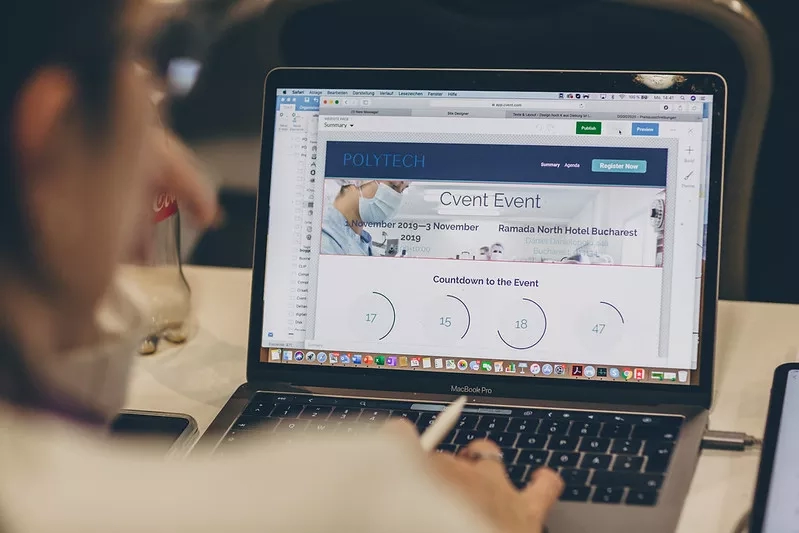The world in which the event planner now operates is changing at an accelerated pace. We live in an increasingly mobile-first, digitized society and delegate expectations have shifted accordingly. Whether it’s an internal employee training workshop, an executive dinner, or a large-scale corporate seminar or trade-show, attendees are demanding ever-more personalized experiences.
However, with a plethora of delegate personas to cater to, how easy is this to achieve today?
According to a survey by Cvent and Edelman Intelligence, attendee expectations and needs differ significantly according to their persona, age, and region. What engages a UK Millennial may not be appropriate for a Baby Boomer from Germany for example. To deliver a unique and engaging experience for every attendee, you need a reliable event management plan in place.
Technology is now the planner’s best friend. It has streamlined and simplified modern event management processes – from venue sourcing and registration to onsite engagement and post-event evaluation, while ensuring that different attendee personas are served by their preferred means of communication and interaction, such as mobile event apps.
First, however, planning successful events that appeal across personas requires a scalable strategy, takes best practices into account, and can achieve key objectives such as, improved ROI, effective collation of delegate data and analysis, efficient registration, enhanced brand presence, and improved stakeholder accountability.
Cvent’s ultimate guide to event management best practices for 2023 can undoubtedly help you achieve this strategy by looking at just seven different elements:
Event goals
Before diving into the dark, complicated world of planning an event, you need to define your event goals. Why are you holding an event? To gain new customers? Conduct training workshops for existing clients? Increase the membership of your association or boost employee morale? Only when the event’s goals have been established can you effectively plan what type of event you need.
It could, for example, be a webinar, fundraiser, roadshow, executive dinner, large-scale conference or exhibition stand at a trade-show.
In order to define the event’s goals, there’s a simple four-point strategy to follow:
- Identify the audience. Who is the target audience? Is the event looking to attract new customers or engage existing clients or qualified prospects? Will it be a training and appreciation session or internal employees and how many attendees are expected?
- What’s your content? And perhaps more importantly, what are the intended takeaways? Does the event content need to drive people to sign-up for something? Or should it inspire, motivate or educate delegates about specific products and services?
- Why are you organizing the event? How does the event align with your organizational objectives? What are the short and long-term goals for the event? Do you need to generate leads? Establish industry credibility? Reward employees or forge new business partnerships? Every event should have a clear-cut purpose form the outset.
- Are your goals measurable? Unless you can measure your goals, you won’t be able to determine the impact of your event. How many leads did you generate? Have you done a cost-benefit analysis? If yes, then what metrics are you using to measure your event ROI?
Event budget
According to Cvent’s 2nd Annual Global Event Industry Benchmarks Study, budgeting is viewed by organizers as the most challenging part of planning and executing events.
Since this part of the strategy is ultimately tied with the financial goals of your organization, it is important to produce a detailed, well-thought-out budget plan that will help you track costs, save time, demonstrate ROI, and make better business decisions.
Once the focus of the event has been defined, you need to create an estimate of all the expenses involved, including overheads and taxes. Remember, your event should be planned around your financial resources, and not vice-versa.
The first step is to make a comprehensive list of all the budget line items in the event lifecycle, such as:
- venue hire
- audio-visual (AV)
- food and beverage
- accommodation and travel
- speaker fees
- marketing and promotion
- service fees and other cost components
The next step is to research the event budget costs to get an estimate pricing as close as possible to the actual cost. This can either be done by checking historical pricing data from previous events and taking inflation into account, or by checking with suppliers and requesting several quotes to get a clearer pricing picture.
Tip: When dealing with suppliers, make sure your brief is as tight as possible, so you get a clear understanding of the costs involved with running your event. Include cost components that are usually left out like tax, gratuities etc. Remember, you need to pick the vendor that fits the vision of your event and is easy to work with. Don’t simply opt for the lowest bidder!
Managing your event budget can be as easy as opening a Google spreadsheet, populating the data and editing the entries. However, developing a manual plan for budgeting and tracking expenses can be an extremely time-consuming process that can lead to a lot of stress.
Today, event management software suites include a dedicated event budget management tool that ensures accurate collection of your budgetary information, while helping you to track your spend easily, generate budget reports, and demonstrate the ROI of your event.
Event marketing
Along with budgeting, event marketing and promotion are among the top three challenges faced by event organizers today. In this age of social media-driven narratives, the way attendees interact with a brand has completely transformed. To drive the right attendees to the right events, you need to cut through the noise and execute a winning event marketing strategy.
Before planning an event marketing strategy, you need to understand your target audience.
- What is the audience demographic?
- What problem is the event solving for attendees?
- What social media channels do attendees use?
- What time of day are the attendees online?
- Why is the event important?
Conclusions drawn from these questions will form the basis of your event marketing strategy.
Every touchpoint and each attendee interaction during the event lifecycle will serve as an opportunity to reinforce your organization’s brand. Since we live in an increasingly connected world, it is essential to incorporate technology to personalize these interactions at scale.
Key channels include:
The event website
An event’s website is the primary and most important touchpoint, as well as a vital promotional tool. Ensure you have a website that is not only pleasing on the eye but is also easy to update and change while maintaining brand consistency. Branding your event website is crucial to the success of your event, so make sure you pay a special focus on the design process.
With the latest event management software solution suites, creating a custom event website has never been easier. There is no technical expertise required, and you certainly don’t need to learn computing coding. With a simple drag-and-drop tool, you can build complete websites from scratch that enable you to collect registrations and payments and promote your event, providing detailed information about what attendees can expect should they choose to attend.
Email marketing
For B2B events, email marketing remains the most preferred mode of driving registrations. Planning an event email marketing campaign requires the utmost care, and even a small slip can result in major legal troubles because you are dealing with the personal information of customers. Make sure you are aware of the GDPR best practices for event management as well as the local regulations for sending emails to contacts.
Once you’ve done your research and pulled potential attendee data from your Excel sheet or CRM, you need to clean the contacts database to manage your future events better.
Most event management software suites provide integrated event email marketing and event contact management solutions, which is a big help if you are looking to simplify and update your address book and send out automated reminders to prospects and customers.
Content marketing
Organizing successful conferences and events requires a meticulous content marketing strategy that covers all aspects before, during and after the event. Your content plan, whether it includes blog posts, press releases, infographics, video series, or a combination of all, should be mapped out way before the event planning process kicks in.
Before the event, explore the theme and generate promotional content around it. A recommended way to get immediate traction from users is to create short video content that can be used across social channels to build audience, interest, and anticipation. Think from the attendee’s perspective about the USP of your event.
On the day of the event, content should be aimed at leveraging live event happenings such as session highlights, speaker quotes, Q&As, and user-generated content through social media channels.
After the event, creating impactful post-event content that reminds the attendees of their memorable experiences is an essential part of an effective event marketing strategy.
Send a follow-up email that showcases different event images or video highlights. This will remind delegates of the fun they had and make them want to come back for more. Also, don’t forget to include a post-event survey.
Social media
Every event marketing strategy should have a social media plan in place. Assess which channels will drive the most engagement and develop a calendar of content that can distribute key messaging before, during and after the event. Also, use social media as a customer service tool to garner delegate feedback and answer any questions quickly and efficiently.
Why not involve your social audience in the planning of the event by posting polls asking them to vote on event elements, speaker topics or other factors that will make them feel engaged and involved?
Another quick and effective way to maximize the reach of your event is to leverage the power of social media influencers. It doesn’t have to be an expensive celebrity endorsement. It could be an industry influencer with a large social following or a niche micro-influencer that specializes in your market sector.
Mobile event apps
Mobile is personal. We depend on them throughout the day to keep us informed, to stay connected as well as entertained. With a mobile event app, you can facilitate seamless and personalized interactions with your target audience.
Offering your delegates a mobile app empowers them to create a stronger, more personal connection with your event before it even begins as they can use it as their personal event tool to help them plan for what they individually want to get out of your event.
During the event, you can send push notifications for updates on new and upcoming sessions, inform attendees about the stuff they must not miss out on during the event, and encourage them to post about their event experience on social networks.
Online event registration
Event strategies are all about increasing attendee registrations. Whether the end-goal is driving sales, generating leads, or building business relationships, you need people to attend the event in large numbers.
Globally, the online event ticketing market is anticipated to grow at a CAGR of 4.8% during 2018-2025, supported by rising internet penetration and growing use of mobile applications to book events. If your attendee is mostly online, it is recommended to use the best online event registration software to get more sign-ups up for your event.
There are also a few innovative event marketing tips and tricks you can employ to increase your registrations, such as early bird discounts, sponsor involvement social influencer engagement.
Onsite event check-in solution
To create a great first impression, the event check-in process should be as quick and smooth as possible, so that the attendees can spend more time exploring the event. Imagine creating a lot of buzz for your event but overlooking the importance of faster check-ins. You will end up with long queues, disgruntled faces, and probably negative feedback as well.
By using event management software that offers onsite check-in and registration facilities, you can reduce this major pain point with ease. With self-servicing kiosks, wireless, on-demand badge printing, and card-swiping services for payments, onsite event check-in solutions provide a plethora of benefits such as:
- Accelerated check-ins
- Paperless forms
- Managing large crowds with ease
- Multiple branding opportunities
- Secure payment system for donations, raffle tickets, and merchandise
- Less manual load for your team
- Onsite reporting and analytics for data analysis
Improving attendee experience
After check-in, the most crucial part of the event management plan is how to ensure a first-class experience for attendees. Creating unforgettable engaging experiences is not an easy task. As the world continues to change, so do attendee expectations. As an event organizer, you can leverage the power of mobile event apps to create engaging and personalized experiences for attendees.
According to a study by TechCrunch, users spend around five hours daily using apps and more time on their mobile devices in general (it’s way more than that, actually). If people are going to stare at their phones most of the time anyhow, why not leverage this to your advantage and gain their attention?
By eliminating the need for paper-based brochures and schedules, these apps allow attendees to be more involved in the event through interactive maps, quizzes, gamification, polls, feedback surveys and more. Mobile apps allow you to send notifications such as last-minute changes to the event program, speaker requests or special discounts for those who have signed up and downloaded the app early.
As well as personalizing their schedules, delegates can see who else is registered to attend, allowing them to plan networking and make appointments.
Event ROI
Once the actual event concludes, the all-important question arises – was your event successful? Did it drive sales? Were you able to reduce costs? You need to provide solid proof of the impact of your event so that the stakeholders can assess whether their investment was a good one or not.
Traditionally, the total number of attendees registering for an event and the post-event feedback survey have been key indicators of how successful an event is. However, event management technology has revolutionized the way event ROI is calculated. You can now measure and optimize your live events in the same way as other elements of the digital marketing mix, like email or your event website.
This will help you make real-time adjustments and plan more personalized experiences for the future.
Here are just a few questions to ask yourself for better event ROI:
- What were the highest-rated content and topics?
- Which sessions saw the highest attendance?
- Which speaker received the most social media mentions and engagement?
- Was the networking time enough for attendees?
Such data can help you improve your events in several aspects, such as estimating food and beverage (F&B) costs, selecting venue and layouts, and utilizing the feedback to create more relevant content.
Measuring the real value of events is not an easy task, due to the numerous tangible and non-tangible factors involved. You need a proper measurement system to calculate event ROI so that you can implement changes in the business process and generate maximum returns. In your event, if there are different leads having their own personalized experiences, how does one measure a factor like delegate satisfaction? Here is a simple template that will help.

Virtual event best practices
There are specific best practices that you should employ when you are running a virtual event. The key is to make sure that your audience is engaged as much as possible, even while sitting behind a computer screen.
Ideally, you should have an emcee act as a sort of TV announcer, getting the audience excited for upcoming sessions and reminding people about networking events. The session lengths should be on the shorter side, so audiences remain engaged, and the event itself should be split into multiple, shorter days as opposed to one long day of sitting at the computer.
Initially, you have to make sure that your speakers are well prepared to speak to a virtual audience, and that they know how to give an engaging virtual presentation. And, one of the most important event best practices is to have a virtual event software that can power you event. The Virtual Attendee Hub is a great tool for virtual events as it acts as part of the event marketing and management platform.
How event management best practices make your event successful?
Corporate event management is akin to a piece of heavy machinery with different intricate parts that must work together as a single cohesive unit to operate successfully. Following clearly defined and relevant best practices will help you plan a strategy for using that machinery that is scalable and successful and achieves key objectives such as:
- Quick, efficient registration, check-in and badging process
- Seamless onsite experience for attendees
- Easy collation of attendee data and analysis
- Personalizing individual experience on a mass scale
- Facilitating networking
- Improving ROI
- Boosting brand presence
- Thorough accountability to stakeholders
Design an event strategy based on the framework in this article and then replicate it as a successful working template for diverse events of varying complexity and scope.











